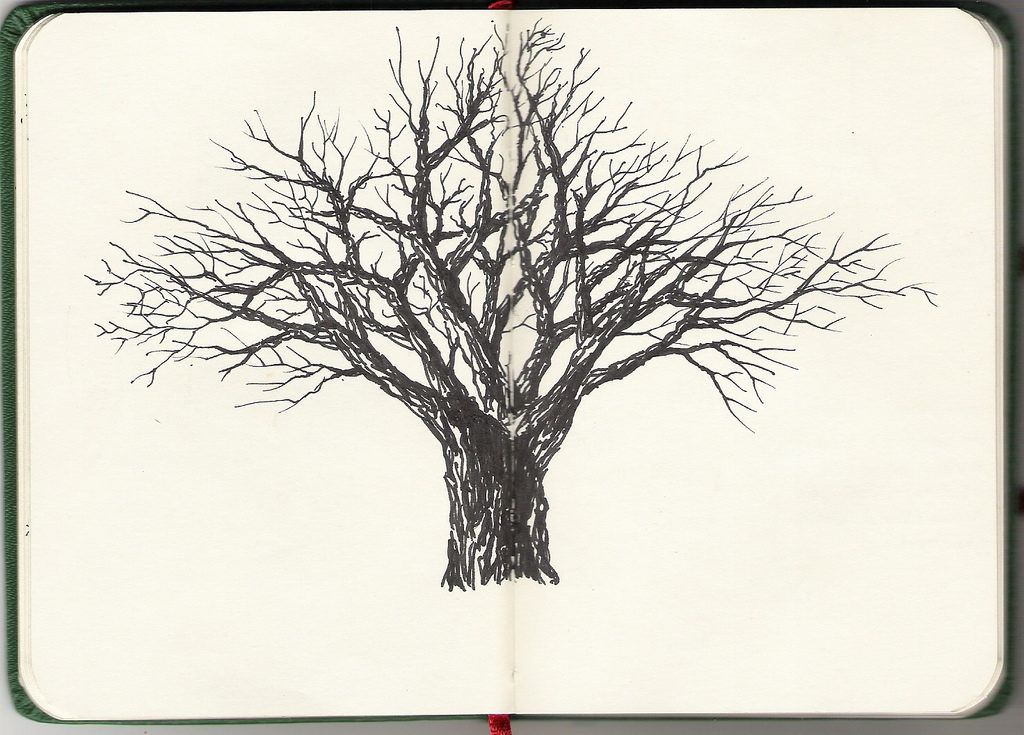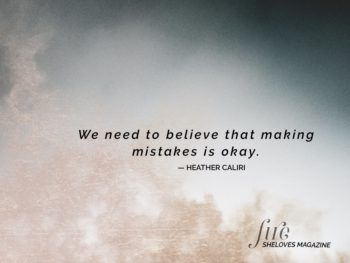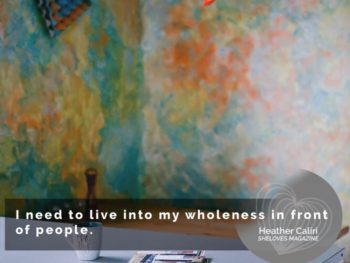
Off and on, I’ve been trying to draw from nature. Leaves. Fruit. Weird seed pods.
Also, trees.
Can I just say that drawing a tree is one of the most frustrating things ever?
How do you draw the whole thing? The branches, the leaves, the canopy? When you look at a tree, you see a tree, but when you try to draw it you see its infinite individual parts and instead of a tree you have a bunch of lines all going different directions. No wholeness. No tree.
A few months back, I got a book on drawing from nature. I paged through until I got to the section on trees. There, I found the secret.
Draw the outline first.
Sketch the shape the tree makes against the sky in a light line, and from there, fill in the details: branches, trunk, and the leaves fluttering in the air.
I’m a little hesitant to write this here, because now that I read it, it seems glaringly obvious. If you start with everything, you can draw nothing. You have to see the tree’s wholeness before you can move on to the details.
Seeing the Forest for the Trees in Real Life
Lately, I’ve noticed that this lesson teaches me more than drawing techniques.
As a perfectionist, I am quick to focus on details. Whether my children should be allowed to watch the Disney channel. How many minutes I should read the Bible in the morning. Whether the grammar, punctuation, or phrasing of my latest essay is correct. These details drown me. I start fixating over good-enough, perfect-enough, and I always seem to fall short.
But over the past few years, I’ve started drawing broad outlines of my life first. I write down my goals and think about what I value. I pray about those decisions. I evaluate periodically whether I’m meeting goals, or whether they’re unreasonable or unworkable. I think about whether they are really upholding my values, whether they are a challenge and blessing or just a checklist.
Being intentional about my goals, values, and limits is like drawing the outline of a tree. It gives me a place to start. It provides a focus and a direction for my efforts. And most importantly, it establishes a limit: showing me where I’ve been unrealistic.
Goals are Scary…But They’re Manageably Scary
I used to think writing down goals was the biggest step ever—the polar opposite of a baby step. And on one hand, I still think it’s a daunting proposition. It’s hard to be honest with yourself about your dreams. Not only that, but saying goals out loud is sure to invite some push-back.
So don’t get me wrong—I know writing down goals is hard. But it’s also a stunningly small step.
It is a broad outline. The list can be changed. You can try something, and cross it off your list if it doesn’t work. A goal gives you permission to do no more than what you decide is reasonable. And it’s a simple way to make sure you’re spending your energy on the things that matter to you—and only those things. You’re just responsible for that one outline you mark out on the paper, not every detail, everywhere.
From Macro to Micro
Let’s be clear: a broad outline isn’t enough. You don’t get “tree” from a silhouette. No: you have to fill in the details to get from outline to a tree.
For me, that means three things:
- I have to break the larger goals into smaller steps. How will I meet the goal each month? Each week? Each day? This is also a time to evaluate if I’m over-committing myself; if I have a thousand weekly tasks to tackle, I’m probably being unrealistic.
- I have to make the goal achievable. “Read the Bible more” is too vague. “Read the Bible five minutes each day” is specific; something I can know if I’ve done.
- I have to create routines that support my goals. I make lists and calendars. I take time each month to check in with how I’m doing. And I get rid of or tweak goals that aren’t working.
- I have to look at how each goal makes me feel. The Bible goal I mentioned in step 2 is a good example. That was my goal for the year, but approaching the Word in that way often makes me feel joyless. I’m trying to think/pray about how to make faith practices happen with joy instead of obligation.
Try This.
My challenge to you is to start as small as you can. Is there one area of your life you want to be more intentional about? Start there, and set one two broad goals for the year. Be as gentle or as challenging to yourself as you feel led. And then, take the time to translate that broad outline into specific action steps you’ll take throughout the year. Teach yourself how to see the tree Teach yourself new ways to be a good steward with the gift you’ve been granted. It doesn’t have to be earth-shattering to be worthwhile. It just requires you paying attention to how to be truly, authentically, intentionally yourself.
Image credit: Daniel Silva Lopes















Hi there, Heather!
Found you on the PBH forum, wanted to say hello. Your blog is lovely! I’m a person of faith and an artist and writer as well. Take care!
Hey, thanks Hilaree! Welcome. I’m really enjoying the course so far–I’m really glad I signed up.